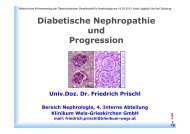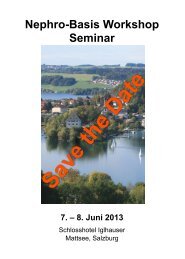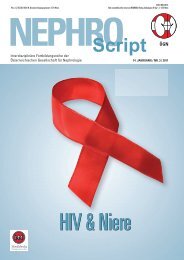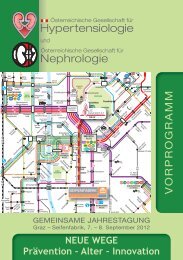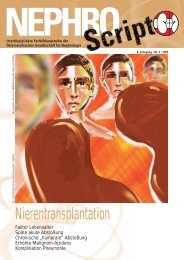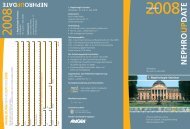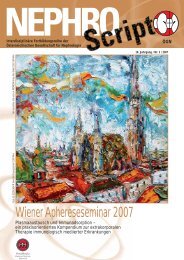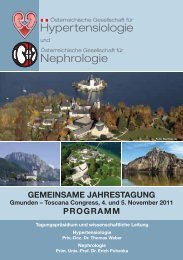Irmgard Neumann - Systemerkrankungen mit Nierenbeteiligung
Irmgard Neumann - Systemerkrankungen mit Nierenbeteiligung
Irmgard Neumann - Systemerkrankungen mit Nierenbeteiligung
Create successful ePaper yourself
Turn your PDF publications into a flip-book with our unique Google optimized e-Paper software.
<strong>Systemerkrankungen</strong> <strong>mit</strong><br />
<strong>Nierenbeteiligung</strong><br />
ÖGN Fuschl 2013<br />
<strong>Irmgard</strong> <strong>Neumann</strong><br />
Wilhelminenspital Wien
• ANCA-Vaskulitis<br />
• Standardtherapie<br />
• MPO and PR3 ANCA - 2 Catagories<br />
• Follow up – Patients at risk<br />
• Remissionserhaltung<br />
• Lupus Nephritis<br />
• Standardtherapie<br />
• Hydroxychloroquine<br />
• Rolle von Rituximab
Induktions-Therapie<br />
Erhaltungs-Therapie<br />
3x0,5-1g Methylprodnisolon<br />
à 1mg/kg Aprednislon<br />
àtaper<br />
plus<br />
Cyclophosphamid (i.v./p.o.)<br />
oder<br />
Rituximab (bevorzugt bei Relapse !)<br />
OCS<br />
Azathioprin (2mg/kg)<br />
MTX (25mg/wk) Cave renal !!<br />
MMF<br />
Rituximab<br />
Dialysepflichtig<br />
+ Plasmaseparation
30 years ANCA - where are we today <br />
• ANCA sind ein Schlüsselbefund in der Diagnostik der SVV<br />
• Nur cANCA/PR3-ANCA und pANCA/MPO-ANCA klinisch relevant<br />
• Der diagnostische Wert von ANCAs bei „nicht-vaskulitischen“<br />
entzündlichen Erkrankungen schlecht untersucht<br />
• Die klinische Bedeutung von ANCAs für das Monitoring der SVV ist<br />
nach wie vor Gegenstand vieler Diskussionen<br />
• Experimentelle in vivo Studien unterstützen die pathogenetische Rolle<br />
von MPO-ANCA, es gibt jedoch kein Tiermodel für PR3-ANCA
The spectrum of ANCA-associated vasculitis syndromes<br />
Falk RJ & Jennette JC. J ASN 2010
PR3 vs MPO-ANCA (regardless of clinical diagnosis)<br />
PR3 <br />
MPO <br />
Age Younger Older <br />
Airway involvement +++ + <br />
Renal li<strong>mit</strong>ed disease + ++ <br />
Inters88al lung disease -‐ ++ <br />
Granulomas ++ -‐ <br />
Relapses +++ + <br />
Cardiovascular events + ++
Frequency of PR3 ANCA and MPO ANCA specificities<br />
by a variety of clinical phenotypes<br />
n=502 (97% renal)<br />
Lionaki, Falk, A&R 2012
à ANCA specificity independently predicts Relapse in AAV with renal disease<br />
Lionaki, Falk, A&R 2012
Relapse free survival<br />
MPO vs PR3<br />
MPO and PR3 ANCA<br />
within Chapel Hill Classif.<br />
MPA<br />
GPA<br />
Lionaki, Falk, A&R 2012
Editorial<br />
Editorial<br />
Editorial<br />
ANCA vasculitis: to lump or split<br />
Why we should study MPA and GPA separately<br />
populations. Thus one could hypothesize that GPA is less<br />
doi:10.1093/rheum<br />
common in Japan because the genes, which play a key<br />
role in pathogenesis, occur much less frequently.<br />
ANCA antigen seems to have a central role in determining<br />
disease phenotype. Appropriate triggers (e.g. infection)<br />
in genetically predisposed people can produce<br />
PR3-associated disease, whereas other environmental<br />
factors (e.g. drugs or silica) result in MPO-associated<br />
disease.<br />
FIG. 1Relative frequency of GPA and MPA across the world.<br />
FIG. 1Relative frequency of GPA and MPA across the world.<br />
The three types of vasculitis associated Classification with ANCA and relapse diagnostic in GPA [4]. criteria Thesebeing findings developed support<br />
[ANCA-associated vasculitis (AAV)] are granulomatosis<br />
will need to include<br />
GPA,<br />
ANCA<br />
but not<br />
specificity<br />
MPA, is triggered<br />
as a discriminating<br />
by an infectio<br />
with polyangiitis (Wegener’s) (GPA), microscopic polyangiitis<br />
(MPA) and eosinophilic granulomatosis with polyan-<br />
ondary to exposure to propylthiouracil and hy<br />
In contrast, drug-induced vasculitis (most co<br />
feature [10]. This will help clarify the distinct clinical<br />
phenotypes of PR3-ANCA and MPO-ANCA–associated<br />
giitis (Churg–Strauss syndrome) (EGPA). They have been typically associated with induction of a vascu<br />
classified together in the majority of classification vasculitis systems and per<strong>mit</strong> MPA with studies MPO-ANCA. into aetiopathogenesis Environmental expo to<br />
published since the introduction of ANCA, use including better-characterized the has beenand associated classified with patients. renal vasculitis, Futurea<br />
most recent 2012 Chapel Hill classification clinical system studies [1]. should these patients be powered also to have study MPA-type GPA and va<br />
GPA and MPA have been considered together MPAinindependently. clinical MPO-ANCA This poses [5]. significant difficulties for<br />
and treatment studies because they sharestudies many clinical under way in There which areGPA significant and MPA differences are combined<br />
outco<br />
features: for example, renal involvement together, is identical and in GPA previous and MPA. studies Walsh et will al. [6], need in a study to be of<br />
both diseases with a pauci immune focal re-evaluated segmentalwithtors thisfor inrelapse mind. inMany 535 patients studieswith areeither underpowered<br />
GP<br />
necrotizing glomerulonephritis. Granulomatous involvement,<br />
particularly of the upper respiratory tract, is a char-<br />
reported that PR3-ANCA positivity was asso<br />
to per<strong>mit</strong><br />
four<br />
this<br />
European<br />
analysis.<br />
studies<br />
Studies<br />
followed<br />
of MPA<br />
up for<br />
will<br />
1804<br />
consequently<br />
be much harder in Caucasian populations,<br />
acteristic feature of GPA, but not of MPA; eosinophilia, much higher risk of relapse than MPA [HR 1<br />
where MPA is relatively uncommon. The epidemiology,<br />
asthma and atopy typically occur in EGPA. More than 1.39, 1.89)], confirming previous reports of r<br />
90% of GPA and MPA patients are ANCA clinical positive. features, In trigger associated factors, with outcome PR3-ANCAand positivity genetic or fac-<br />
specificity stronglyofsuggest Thethat recently GPA and completed MPA should Genome-Wide be con-<br />
GPA<br />
most European studies, the ANCA antigentors<br />
GPA is predominantly proteinase 3 (PR3), sidered and in MPA as separate is Study diseases. in AAV has provided further evidenc<br />
predominantly myeloperoxidase (MPO). Only 50% of and MPA should be viewed as separate<br />
Funding: No funding was received.<br />
EGPA patients are ANCA positive, mostly MPO. GPA The patients studied were from the UK a<br />
and MPA are traditionally treated in the same way with Europe, where the link between disease (G<br />
Richard A. Watts 1 and David G. I. Scott 2<br />
populations. Thus glucocorticoids one could hypothesize and immunosuppressive that GPA is less Accepted drugs. 13 July 2012 and ANCA specificity is closest. The genetic<br />
common in Japan Recent because epidemiological, the genes, which play genetic, a key outcome Correspondence 1 Department and trial to: of Richard Rheumatology, were A. Watts, studied Department Ipswich for ANCA of Hospital specificity NHS(PR3 Trust, an<br />
role in pathogenesis, data suggest occur much thatless considering frequently. GPA and MPA<br />
Rheumatology, Ipswich as a and single<br />
Ipswich 2 Norwich Hospital<br />
clinical Medical NHSphenotype. Trust, School, Ipswich IP4<br />
PR3-ANCA University ofwas Eastasso<br />
5PD, UK.<br />
ANCA antigen entity seems fortothe havepurposes a central role ofinclinical determin- studiesAnglia, E-mail:<br />
and<br />
Richard.watts@ipswichhospital.nhs.uk<br />
trials Norwich, is UK. HLA-DP, Rheumatology SERPINA1 and2012<br />
PRTN3, whereas<br />
Downloaded from http://rheumatology.oxfordjournals.org/ at
Unterschiede zwischen PR3-and MPO-ANCA-subsets<br />
• PR3-und MPO-ANCA subsets sind genetisch verschieden<br />
Genome-wide association study: 2687 European (GPA and MPA) , 7650 matched controls<br />
HLA-DP, SERPINA 1, PRTN3 for PR3 ANCA,<br />
HLA-DQ for MPO-ANCA (NEJM 2012)<br />
• Geographische Unterschiede in der Prävalenz von PR3-ANCA<br />
und MPO-ANCA<br />
• Extra-renale Manifestationen, Granulome und Relapse sind bei<br />
PR3-ANCA +ven Patienten häufiger<br />
• Nierenhistologie: Aktive und chronische Läsionen häufiger bei<br />
MPO-ANCA+ven Patienten<br />
• Kein Tiermodel für PR3 disease<br />
Unterschiede in der Pathogenese, Ätiologie..<br />
… Therapeutische Implikationen
Renale Prognose: Relapse – active renal disease<br />
Schlüsselbefund = Hämaturie !!! dysmorphe Erys, Zylinder, ev Proteinurie<br />
Renal survival according to the histologic categories<br />
Pictures I. Bajema<br />
A Berden, JASN 2010
Maintenance Therapy - IMPROVE<br />
Time to First Relapse and First Major Relapse<br />
Hiemstra, JAMA 2010
CYCLOPS – long term follow-up<br />
Data of 148 patients<br />
Median follow-up 4.3 years<br />
P=0.029<br />
Harper, Ann Rheum Dis 2012
CYCLOPS – long term follow-up<br />
Pulse daily oral (DO)<br />
Deaths 13 12<br />
Relapse rate patient –year 0.18 0.08 p
GPA and Relapse<br />
Disease-free interval and carrier status.<br />
57 patients with GPA grouped according<br />
to Staphylococcus aureus; p
Risikofaktoren für Relapse<br />
Relapse – Risiko ist variabel<br />
• GPA oder PR3-ANCA (vs. MPA)<br />
• ANCA positiv in Remission<br />
• Steigende ANCA-Titer<br />
• HNO<br />
• Lungenbeteiligung<br />
• GPA: Staph aureus carrier<br />
• SKrea 2 bis 3,0 mg/dl am Ende der Induktions-Therapie<br />
• Weniger CYC zur Induktion (CYCOPS, MYCYC)
Rituximab - Remissions -Erhaltung<br />
- Zeitintervall zum Relapse ist variabel<br />
- Risiko bei 6 Monaten↑<br />
- B Zell Re-Population ~10 Monat, aber variabel<br />
à mehr Relapse nach B-cell return<br />
• Relapse nicht <strong>mit</strong> ANCA -Anstieg assoziiert<br />
• Einige Relapse auch ohne B-Zellen<br />
- „Add on“ RIT zu anderen IS-à Infektionen unverändert
RITUXIMAB – Maintenance for refractory AAV<br />
Protocolized versus non-protocolized TX<br />
% 56 ENT, 34 lung, 27 joint, 16 renal, 12 eye, 12 skin, 7 PNP, 7 CNS<br />
RITUXIMAB<br />
Group A (n=28)<br />
Group B (n= 45)<br />
Group C (n=19)<br />
1g x 2 or 375mg/m2 x 4; repeated at relapse<br />
1g x 2 à 1x1g every 6 mo for 2 years (6g total)<br />
relapsers from Group A->followed by Scheme B<br />
A B C<br />
Response 26/28 (93%) 43/45 (95%) 18/19 (95%)<br />
Relapses at 2 years 19/26 (73%) 5/43 (12%)** 2/18 (11%)**<br />
Relapses at last f-up 22/26 (85%) 11/43 (26%)** 10/18 (56%)**<br />
(median 44 mo)<br />
SAEs 16 in 19 pts 32% 45 in 21pts 47% 20 in 7pts 37%<br />
Infections 10 30* 14<br />
*13 in 2 pts<br />
** p
n=19<br />
n=19<br />
n=28<br />
2g 6g relapsers<br />
àwait<br />
from A<br />
à 6g<br />
S<strong>mit</strong>h R,Jayne A&R, 2012
Ausschnitt<br />
• All (n=8) Remission by 6 months<br />
• Mean follow-up 12 mo (6-30), no deaths, no further severe infections<br />
à RTX can be considered for gen AAV and conco<strong>mit</strong>ant severe infection
Lupus Nephritis<br />
Standardtherapie<br />
-Hydroxychloroquine<br />
Rolle von Rituximab
Downloaded from ard.bmj.com on September 10, 2012 - Published by group.bmj.com<br />
ARD Online First, published on July 31, 2012 as 10.1136/annrheumdis-2012-201940<br />
Recommendation<br />
Joint European League Against Rheumatism and<br />
European Renal Association–European Dialysis and<br />
Transplant Association (EULAR/ERA-EDTA)<br />
recommendations for the management of adult and<br />
paediatric lupus nephritis<br />
George K Bertsias, 1 Maria Tektonidou, 2 Zahir Amoura, 3 Martin Aringer, 4<br />
Ingeborg Bajema, 5 Jo H M Berden, 6 John Boletis, 7 Ricard Cervera, 8 Thomas Dörner, 9<br />
Andrea Doria, 10 Franco Ferrario, 11 Jürgen Floege, 12 Frederic A Houssiau, 13<br />
John P A Ioannidis, 14 David A Isenberg, 15 Cees G M Kallenberg, 16 Liz Lightstone, 17<br />
Stephen D Marks, 18 Alberto Martini, 19 Gabriela Moroni, 20 <strong>Irmgard</strong> <strong>Neumann</strong>, 21<br />
Manuel Praga, 22 Matthias Schneider, 23 Argyre Starra, 24 Vladimir Tesar, 25<br />
Carlos Vasconcelos, 26 Ronald F van Vollenhoven, 27 Helena Zakharova, 28<br />
Marion Haubitz, 29 Caroline Gordon, 30 David Jayne, 31 Di<strong>mit</strong>rios T Boumpas 1<br />
ditional data are<br />
shed online only. To view<br />
files please visit the<br />
al online (http://ard.bmj.<br />
umbered affiliations see<br />
f article.<br />
espondence to<br />
i<strong>mit</strong>rios T Boumpas,<br />
ABSTRACT<br />
Objectives To develop recommendations for<br />
the management of adult and paediatric lupus nephritis<br />
(LN).<br />
Methods The available evidence was systematically<br />
reviewed using the PubMed database. A modified Delphi<br />
method was used to compile questions, elicit expert<br />
opinions and reach consensus.<br />
Results Immunosuppressive treatment should be<br />
INTRODUCTION<br />
Approximately 50% of patients with systemic<br />
Ann Rheum Dis 2012<br />
lupus erythematosus (SLE) will develop lupus<br />
nephritis (LN), which increases the risks for renal<br />
failure, cardiovascular disease and death. In 2008,<br />
we published the first European League Against<br />
Rheumatism (EULAR) recommendations on the<br />
management of SLE. 1 Since then, several controlled<br />
trials have been published upon which updated
EULAR/ERA-EDTA Recommendations<br />
for the management of lupus nephritis 2012<br />
Indikation zur Nierenbiopsie bei SLE<br />
Jeder Hinweis auf eine <strong>Nierenbeteiligung</strong><br />
- reproduzierbare Proteinurie ≥0.5 g/24h<br />
- insbesonere + glomerulärer Hämaturie<br />
In Erwägung zu ziehen bei:<br />
- isolierter glomerulärer Hämaturie<br />
- isolierter Leukurie (nach Ausschluß einer Infektion)<br />
- ungeklärter Niereninsuffzienz bei unauffälligem Harnsediment<br />
(insbesondere bei aPL-AK)<br />
Klinische, serologische oder andere Laborparameter<br />
korrellieren nicht (ausreichend) <strong>mit</strong> der Nierenhistologie !
EULAR/ERA-EDTA Recommendations<br />
for the management of lupus nephritis 2012<br />
Beurteilung der Nierenbiopsie<br />
à ISN/RPS 2003 classification system (àglomeruläre Veränderungen)<br />
à UND - Activity und Chronicity Indices<br />
- Tubulointerstitielle Läsionen<br />
- Vasculäre Veränderungen (insbes. bei APL - Antikörpern)<br />
• ) Adäquates Sample für Lichtmikroskopie (≥8 glomeruli)<br />
4 Färbungen (H&E, PAS, trichrome silver)<br />
• ) Immunohistologie (IgG, IgA, IgM, C3, C1q, κ and λ light chains)<br />
insbesondere bei LN V<br />
• ) ELMI hilfreich in einzelnen Fällen
Therapie -Konzept<br />
• Immunsuppressive Therapie<br />
à immunologische Remission<br />
- renal<br />
- extrarenal<br />
- serologisch<br />
Induktionstherapie à Erhaltungstherapie<br />
• Nicht-immunsuppressive Therapie<br />
• ACE-I +/- ARB bei Proteinurie (>0.5 g/24-‐hr) Hypertonie<br />
• RR-Therapie<br />
• Statine (LDL < 100 mg/dL) KHK-Risiko 5–8 x erhöht !<br />
• Hydroxychloroquin<br />
• Vit D<br />
• Antikoagulation - Nephrotisches Syndrom, SAlb
Lupus nephritis Initial treatment<br />
EULAR/ERA-EDTA Recommendations<br />
for the management of lupus nephritis 2012<br />
Class IIIA or IIIA/C (±V)<br />
Class IVA or IVA/C (±V)<br />
MMF (3 g / day)<br />
oder<br />
Low-dose i.v. CYC<br />
(3g, Euro Lupus)<br />
+ Glucocorticoide: Initial: 3 x IV Methylprednisolon 500-750 mg<br />
à oral Prednisolone 0.5 mg/kg/d für 4 Wochen,<br />
reduzieren bis ≤10 mg/d <strong>mit</strong> Monat 4 bis 6<br />
Ungünstige prognostische Faktoren (rascher Abfall der GFR, Histologie)<br />
àCYC 1x/Monat in höheren Dosen (0.75-1g/m2) für 6 Monate<br />
Non-responders unter MMF od CYC<br />
à switch von MMF auf CYC bzw. CYC auf MMF<br />
à Rituximab<br />
IVIG, PLEX, IA
Lupus nephritis Initial treatment<br />
EULAR/ERA-EDTA Recommendations<br />
for the management of lupus nephritis 2012<br />
Class V LN<br />
MMF (3 g/day)<br />
+ oral Prednisolon (0.5 mg/kg/day)<br />
Non-responders: CYC<br />
Calcineurin inhibitors (Cyclosporin A, Tacrolimus)<br />
Rituximab<br />
Class II LN <strong>mit</strong> Proteinurie > 1 g/day (unter ACEI/ARB):<br />
Corticosteroide (0.25-0.5mg/kg/d)<br />
+/- Azathioprin (1-2 mg/kg/d)
Lupus nephritis Subsequent Treatment<br />
EULAR/ERA-EDTA Recommendations<br />
for the management of lupus nephritis 2012<br />
MMF (2 g/day)<br />
oder AZA (2 mg/kg/day) mindestens 3 Jahre<br />
+ low dose prednisone<br />
(5-7.5 mg/day)<br />
Calcineurin inhibitors diskutiert bei LN V<br />
Generell:<br />
- Ausschleichen der Substanzen, Gucocorticoide zuerst<br />
- Bei initial gutem Ansprechen auf MMF gut à MMF belassen<br />
- Schwangerschaft geplant àswitch auf AZA
Maintenance Therapy - For how long<br />
risk factors for progression to CKD:<br />
• African, Hispanic ethnicity<br />
• young age,<br />
• BX: crescents<br />
• lack of complete remission<br />
• persistently elevated Screatinine or sign proteinuria<br />
• persistently elevated APL-AB<br />
• persistently low levels of C3<br />
• frequent relapses<br />
Risk factors for renal flare<br />
• Young age at onset of SLE (
Severe LN – Induction MMF versus CYC<br />
Systematic review – pooled results<br />
Definition:<br />
• Class IV >15% cresc and/or glomerular capillary necrosis (often Screa↑)<br />
• Relapsing disease despite CYC (often Screa↑)<br />
• Proliferative LN (III or IV) with impaired renal function<br />
-> studies & personal communication: n= 382<br />
à MMF and CYC equally effective in inducing remission<br />
à Relapse rate, risk of ESRD higher in MMF<br />
Rovin B, CJASN 2013
HCQ - Clinical Benefits<br />
SLE : Less flares (HCQ-discontinuation à 6x greater rate of flares)<br />
Lower prednisone doses Canadian HCQ Study Group (NEJM 1991)<br />
LN: Multiple cohort studies (29 and 1480 SLE patients)<br />
Lower incidence and prevalence of renal disease wilth HCQ<br />
(A& Rheum 2005; A& Rheum 2010)<br />
Less nephritic flares<br />
random withdrawl study, 3yrs f-up, n=47<br />
-> 74% reduction risk of nephritic flares with HCQ (4% vs 14%)<br />
(Tsakones,Lupus 98)<br />
Reduced risk of developing renal disease (n=203)<br />
lower frequ.of CLASS IV LN<br />
lower GC doses<br />
lower SLE activity (LUNIMA, 2009)<br />
Improvement of renal outcomes in LN III+/-V, IV+/- V at 12 months<br />
(Hopkins lupus Cohort 2006,<br />
Lupus 2006, 2008, A&Rheum 2009)
HCQ - Clinical Benefits<br />
Lipids: Tgl↓ LDL↓ HDL↑<br />
Improves glucose profiles (↑binding of insulin to ist receptor)<br />
à metabolic syndrome ↓<br />
Reduces risk of malignancy<br />
Thromboprotective
B- Zell Depletion bei Lupus Nephritis<br />
Background<br />
SLE: 5-6 fach erhöhtes Risiko für KHK<br />
(chronische Entzündung, Immunosuppression)<br />
LN:<br />
Response auf CYC oder MMF: 30-60% < 6 Monaten<br />
55-80% 50% erhalten noch 10 Jahre nach Diagnose eine IS
Rituximab bei Lupus Nephritis<br />
Review: 300 Patienten, 21 Studien<br />
Häufigste Indikation für Rituximab: Refraktäre oder Relapsierende LN<br />
Follow-up 3-36 Monate; nur 11/21 Studien: follow-up >12 Monate<br />
Follow-up period >12 months<br />
Response rate (CR+PR) 50-100%<br />
(median 80%)<br />
No benefit for combining other immunosuppressive agents with Rituximab<br />
J W. Gregersen, D. R. W. Jayne Nat. Rev. Nephrol. 2012





